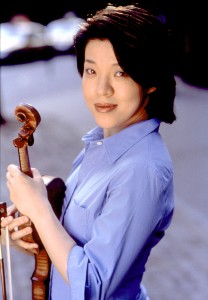Early Webern and Late Brahms at the Symphony
Anton Webern, the Austrian composer who took the 12-tone method of his teacher Arnold Schoenberg to dazzling heights, met a sad and untimely end. Although he survived World War II as a civilian, a few months after the Nazi surrender he was mistakenly shot by an occupying American Army private when he lit a cigar on his front porch 45 minutes before curfew.
In the years following the war, Europe’s musical avant garde resurrected Webern’s austere serial music as the new music standard, bullying even respected composers such as Stravinsky and Copland into adopting 12-tone methodology. At Friday’s (April 12) San Diego Symphony concert, Music Director Jahja Ling gave us a taste of Webern’s music before he studied with Schoenberg in the form of his 1904 tone poem “Im Sommerwind.”
Inspired by a poem praising the rejuvenating effects of nature on pallid urbanites, “Im Sommerwind” (“In the Summer’s Wind”) vividly evokes bucolic languor with all the colors of a large orchestra used selectively in the mode of Gustav Mahler or Richard Strauss. Ling meticulously guided his forces through its vivid contrasts and shifting textures, coaxing an unusually warm color from the strings.
The only hints of Webern’s eventual severe serial idiom were the occasional wispy, unaccompanied woodwind solos and a gossamer duet between Concertmaster Jeff Thayer and Principal Second Violin Alexander Palamidis, which they gracefully executed. Overall, “Im Sommerwind” proved an emotionally satisfying 15-minute gem, an intimation of the Impressionist Webern might have become had he not met Schoenberg a few months after completing this composition.
From the Second Viennese School we lept back in time to the First Viennese School with Franz Schubert’s Fifth Symphony, which Ling aptly conceived as a chamber symphony, reducing the orchestra to some 40 players. If only he had been able to reduce the length of this ambling symphony, particularly the second movement. Marked Andante con moto, most the motion I experienced was my attention meandering while Herr Schubert pasted on yet another sweet melody his extended thematic collage.
Ling and the orchestra offered a polished, sympathetic account of Schubert’s Fifth, notably the rousing Menuetto with its dark, minor-mode motifs that allude to Mozart’s great G Minor Symphony No. 40.
Japanese violinist Kyoko Takezawa brought her ample technique and insight to Brahms’ familiar Violin Concerto in D Major,[php snippet=1] providing just enough rubato and unexpected emphases to make the listener glad to be hearing a live performance and not a safely recorded one. I appreciated her restraint and precision in the first-movement cadenza and the fire she saved for the Allegro giocoso, although for the concerto’s strong orchestral climaxes, more power from the soloist would have been desirable. She and Ling were of a single mind in the concerto: strong on Brahms’ breadth and nobility. They did not complete it in record time.
Over the current season we have heard Violin Concertos by Sibelius, Mendelssohn, Shostakovich, and Brahms, and next month Joshua Bell will add the Tchaikovsky. Is it possible to hope for greater variety of styles and fewer chestnuts in the future?
[box] This program by the San Diego Symphony repeats Saturday, April 13, at 8:00 p.m. and Sunday, April 14, at 2:00 p.m.[/box]



